Syngene International Bundle
How Does Syngene International Conquer the CRDMO Arena?
In the dynamic world of pharmaceuticals and biotechnology, understanding the competitive landscape is crucial for strategic success. Syngene International, a leading biopharmaceutical company, has carved a significant niche in the Contract Research, Development, and Manufacturing Organization (CRDMO) space. But how does this Indian giant navigate the intense competition and maintain its market position?
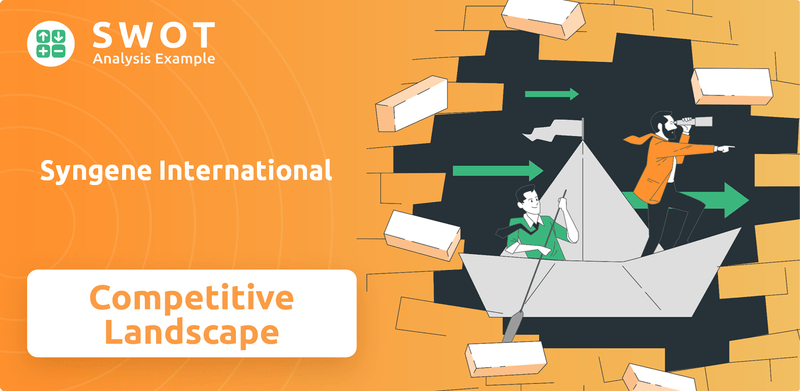
This Syngene International SWOT Analysis delves deep into the company's competitive positioning, examining its strengths, weaknesses, opportunities, and threats. We'll dissect Syngene's key rivals, analyze its financial performance, and explore its growth strategy within the context of the evolving biopharmaceutical industry. This comprehensive company analysis provides actionable insights for investors and industry professionals seeking to understand Syngene International's future prospects and investment potential.
Where Does Syngene International’ Stand in the Current Market?
Syngene International holds a significant position in the global Contract Research, Development, and Manufacturing Organization (CRDMO) market. The company offers integrated services, including drug discovery, development, and commercial manufacturing. Its strong performance, with a 10% revenue growth to INR 25,698 million for the nine months ending December 31, 2023, reflects its robust operational capabilities.
The company's value proposition lies in its comprehensive, end-to-end solutions, which attract major pharmaceutical and biotechnology clients worldwide. Syngene's strategic shift towards integrated services and higher-value offerings has allowed it to capture a larger share of client spending. This approach reduces reliance on individual service lines and enhances its competitive edge. For example, the profit after tax grew by 10% to INR 1,189 million in Q3 FY24.
Geographically, Syngene has a strong presence in India, where its state-of-the-art research and manufacturing facilities are located. Its customer base, however, is predominantly global, serving major pharmaceutical and biotechnology companies in North America, Europe, and Asia. This global reach, combined with its integrated service offerings, positions Syngene as a preferred partner for clients seeking comprehensive solutions. You can learn more about the company from the Brief History of Syngene International.
Syngene's market position is strengthened by its integrated services model, covering the entire drug lifecycle. This approach allows it to serve as a comprehensive partner for clients, from early-stage research to commercial manufacturing. This strategy has enabled strong financial performance.
The company's service portfolio includes drug discovery, drug development, and commercial manufacturing. This diversification reduces its reliance on any single service line. Syngene's ability to provide a range of services enhances its appeal to a broad client base.
Syngene's financial performance reflects its operational efficiency and client demand. The company's profit after tax grew by 10% to INR 1,189 million in Q3 FY24. This robust financial standing, as compared to many industry averages, indicates strong operational efficiency and client demand.
Syngene has a strong presence in India with a global customer base. Its global reach and integrated service offerings position it as a preferred partner. This global reach allows Syngene to serve major pharmaceutical and biotechnology companies across North America, Europe, and Asia.
Syngene's competitive advantages include its integrated service offerings, strong financial performance, and global reach. The company's focus on end-to-end solutions, from drug discovery to commercial manufacturing, sets it apart. The company's ability to provide a range of services enhances its appeal to a broad client base.
- Integrated Services: Offering comprehensive solutions across the drug development lifecycle.
- Financial Strength: Demonstrated by consistent revenue growth and profitability.
- Global Presence: Serving major pharmaceutical and biotechnology companies worldwide.
- Strategic Focus: Shifting towards higher-value services to capture a larger share of client spending.
Syngene International SWOT Analysis
- Complete SWOT Breakdown
- Fully Customizable
- Editable in Excel & Word
- Professional Formatting
- Investor-Ready Format
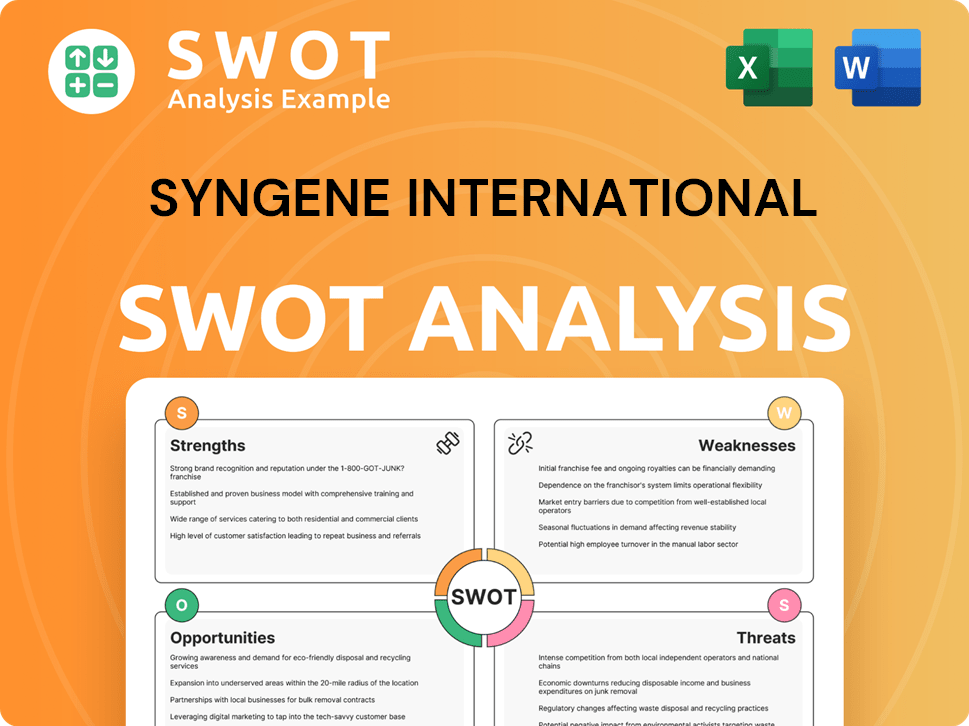
Who Are the Main Competitors Challenging Syngene International?
The competitive landscape for Syngene International is complex, characterized by a mix of large, established players and specialized firms. As a leading biopharmaceutical company, Syngene faces competition across various service offerings, including research, development, and manufacturing. Understanding the market position of Syngene and its rivals is crucial for assessing its performance and future prospects.
Syngene International operates within the Contract Research, Development, and Manufacturing Organization (CRDMO) sector, a global market that is constantly evolving. The company's ability to compete effectively depends on its ability to differentiate itself through innovation, service quality, and strategic partnerships. The Syngene competitors are diverse, each bringing their unique strengths and strategies to the market.
The CRDMO sector is dynamic, with mergers, acquisitions, and technological advancements constantly reshaping the competitive environment. The following analysis provides insights into the key competitors and their impact on Syngene's business.
Lonza is a major global competitor, offering extensive biopharmaceutical development and manufacturing services. The company's strong global presence and diverse capabilities, including cell and gene therapies, make it a significant player. In 2023, Lonza reported sales of CHF 6.7 billion, reflecting its substantial scale and market reach.
Catalent is a leading US-based CDMO with broad expertise in drug development solutions. It provides services ranging from formulation development to commercial manufacturing, including expertise in oral and injectable dose forms. Catalent's revenue for the fiscal year 2023 was approximately $4.3 billion, indicating its strong position in the market.
Charles River Laboratories is a significant competitor, particularly in early-stage drug discovery and preclinical development. The company offers a wide range of services that overlap with Syngene's discovery services. Charles River's revenue in 2023 reached approximately $4.0 billion, highlighting its strong presence in the early drug development phases.
Evotec is a German company known for its drug discovery platforms and integrated R&D solutions. It directly challenges Syngene in the early discovery phase. Evotec's revenue in 2023 was approximately €800 million, showing its specialized focus and capabilities in drug discovery.
WuXi AppTec, based in China, has rapidly expanded its capabilities across drug discovery and development. It leverages its scale and competitive pricing, especially in the Asian market. WuXi AppTec's revenue in 2023 was approximately $39.8 billion, reflecting its significant growth and market penetration.
Thermo Fisher Scientific's Patheon business offers comprehensive CDMO services, including drug substance and drug product manufacturing. It benefits from the extensive resources of its parent company. Thermo Fisher Scientific's total revenue in 2023 was approximately $42.9 billion, with a significant portion attributed to its healthcare-related businesses.
The competitive landscape is influenced by several factors, including technological advancements, geographical expansion, and strategic partnerships. The increasing demand for specialized services, such as cell and gene therapy manufacturing, is creating new opportunities and challenges. For a detailed look at how Syngene is navigating these challenges, consider reading about the Growth Strategy of Syngene International.
- Market Share Analysis: Analyzing the market share of each competitor provides insights into their relative strengths and weaknesses.
- Financial Performance Review: Reviewing financial data, such as revenue growth, profitability, and R&D spending, helps assess the financial health and strategic focus of each company.
- Competitive Advantages: Identifying the unique selling propositions and core competencies of each competitor, such as specialized technologies or geographic presence, is critical.
- SWOT Analysis: Conducting a SWOT analysis (Strengths, Weaknesses, Opportunities, Threats) for each competitor provides a comprehensive view of their strategic position.
- Industry Outlook: Understanding the broader trends in the CRDMO industry, such as the growth of biologics and the increasing demand for outsourcing, informs strategic decisions.
- Recent Acquisitions and Partnerships: Monitoring mergers, acquisitions, and strategic partnerships helps understand how companies are expanding their capabilities and market reach.
Syngene International PESTLE Analysis
- Covers All 6 PESTLE Categories
- No Research Needed – Save Hours of Work
- Built by Experts, Trusted by Consultants
- Instant Download, Ready to Use
- 100% Editable, Fully Customizable
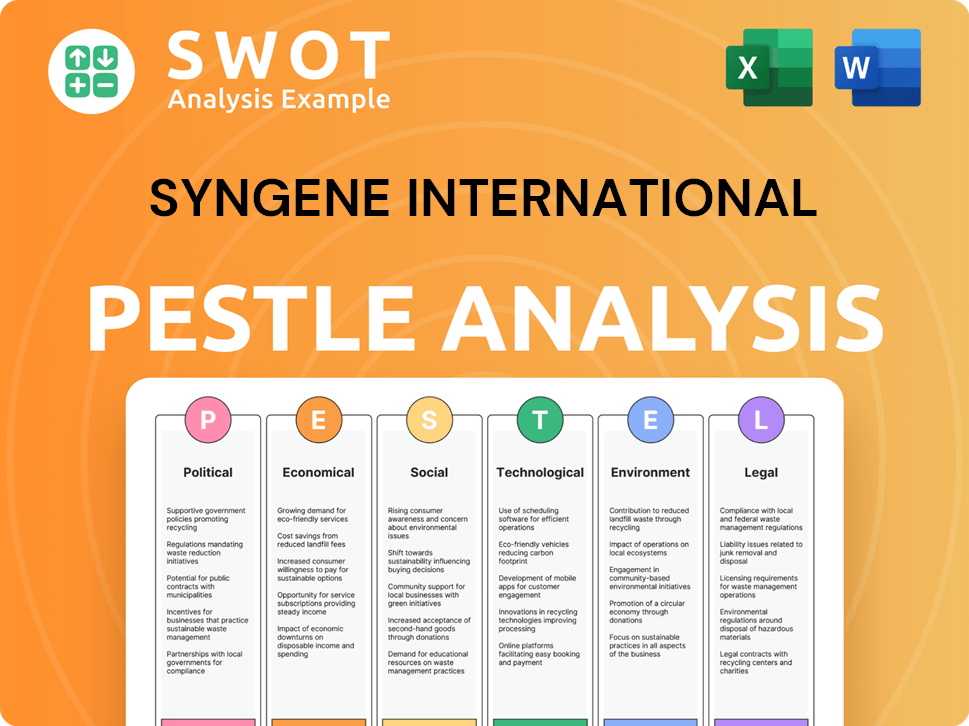
What Gives Syngene International a Competitive Edge Over Its Rivals?
The competitive landscape of Owners & Shareholders of Syngene International is shaped by its strategic advantages in the biopharmaceutical sector. Syngene International distinguishes itself through its integrated CRDMO model, offering comprehensive services from early discovery to commercial manufacturing. This approach allows for end-to-end project management and fosters long-term partnerships, setting it apart from competitors specializing in specific areas.
Syngene's operational excellence is underpinned by state-of-the-art infrastructure and a strong scientific talent pool. The company's investments in advanced technologies and its ability to attract and retain skilled professionals in India contribute to high-quality service delivery at competitive costs. This combination supports its proprietary technologies and intellectual property, enhancing its market position.
Syngene's ability to consistently deliver high-quality results has fostered strong brand equity and customer loyalty among its global clientele. The company's operational efficiencies, driven by lean manufacturing principles, contribute to faster turnaround times and cost-effectiveness, which are critical factors for pharmaceutical clients. These advantages have evolved over time with continuous investment in technology and human capital.
Syngene's integrated CRDMO (Contract Research, Development, and Manufacturing Organization) model provides comprehensive services from early discovery to commercial manufacturing. This end-to-end approach allows for greater control over projects and fosters long-term partnerships with clients. This model is a key differentiator in the competitive landscape.
The company's state-of-the-art infrastructure includes advanced laboratories, pilot plants, and commercial manufacturing facilities. These facilities are built to global regulatory standards, such as those of the US FDA and EMA. Investments in advanced analytical capabilities and high-throughput screening technologies enhance drug discovery and development efficiency.
Syngene benefits from India's abundant supply of skilled scientists and engineers, combined with its rigorous recruitment and training programs. This talent base enables the company to offer high-quality services at competitive costs. This talent pool supports its proprietary technologies and intellectual property.
Syngene's deep understanding of the pharmaceutical R&D process and its ability to consistently deliver high-quality results have fostered strong brand equity and customer loyalty. Many of its global clients are repeat customers. The company's focus on client satisfaction contributes to its sustainable competitive advantage.
Syngene International's competitive advantages are multifaceted, including its integrated CRDMO model, advanced infrastructure, and strong scientific talent pool. These factors contribute to its ability to provide comprehensive services and maintain strong client relationships.
- Integrated CRDMO model offering end-to-end services.
- State-of-the-art infrastructure and advanced technologies.
- Strong scientific talent pool and competitive cost structure.
- Deep understanding of the pharmaceutical R&D process.
Syngene International Business Model Canvas
- Complete 9-Block Business Model Canvas
- Effortlessly Communicate Your Business Strategy
- Investor-Ready BMC Format
- 100% Editable and Customizable
- Clear and Structured Layout
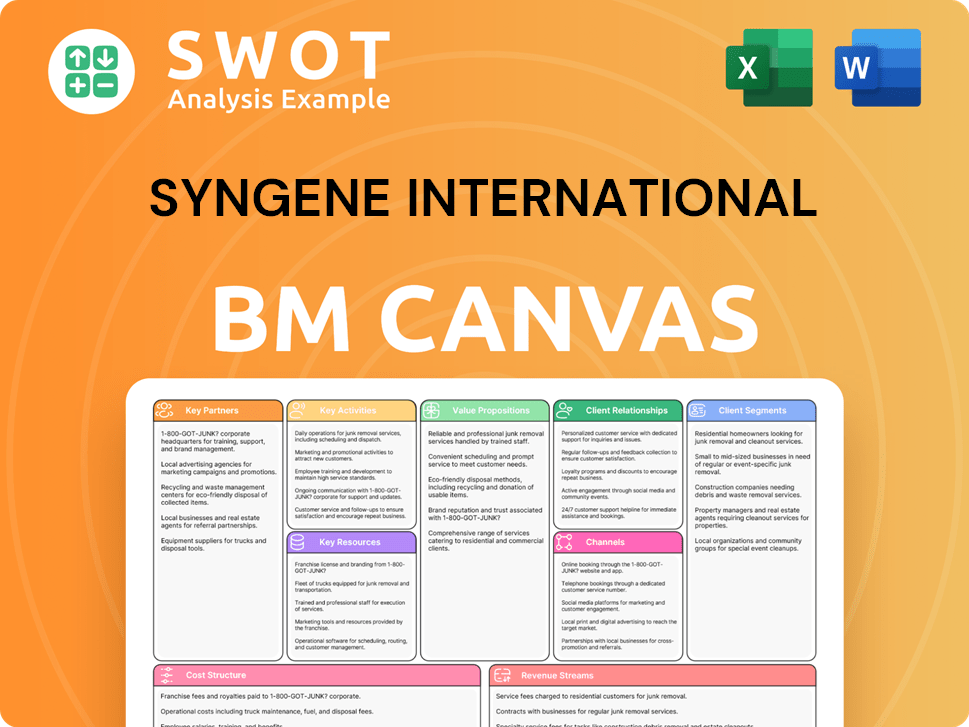
What Industry Trends Are Reshaping Syngene International’s Competitive Landscape?
The CRDMO industry, where Syngene International operates, is experiencing significant shifts due to technological advancements and evolving market demands. The competitive landscape for this biopharmaceutical company is influenced by factors like the increasing need for integrated services and the rapid growth of the biologics market. Understanding the industry trends and future challenges is crucial for evaluating Syngene International's market position and growth potential. An in-depth company analysis reveals the strategic positioning and competitive advantages of Syngene International.
Several factors shape the competitive landscape of Syngene International. These include the rise of AI and ML in drug discovery, stricter regulatory measures, and global economic dynamics. The demand for end-to-end solutions and the expanding biologics market further influence the industry. Recognizing these trends is vital for assessing the opportunities and risks that Syngene's faces and understanding the potential for future growth. For more insights, explore the Marketing Strategy of Syngene International.
Technological advancements, particularly AI and ML, are transforming R&D. Regulatory changes, including stricter quality control, also play a role. The demand for integrated services is increasing, and the biologics market is rapidly growing. These trends affect the strategies of Syngene International and its competitors.
Intense competition from established and emerging CRDMOs puts pressure on pricing and market share. Significant capital expenditure is needed for technology and infrastructure. Talent acquisition and retention remain challenging, and geopolitical factors can disrupt operations. Addressing these challenges is crucial for Syngene's success.
The growing global R&D pipeline, especially in oncology and advanced therapies, offers a large market. Expansion into emerging markets and strategic partnerships create new revenue streams. Digital transformation and capacity expansion are key for capitalizing on these opportunities. Syngene International can leverage its strengths for growth.
The company focuses on expanding integrated service offerings and leveraging its cost-effective model. This strategy aims to capitalize on outsourcing trends in life sciences. The goal is to achieve resilient growth amid evolving industry dynamics, positioning Syngene International for future success. This approach is critical for sustained performance.
The company must navigate the competitive landscape by investing in technology and expanding its service offerings. Strategic partnerships and a focus on emerging markets are crucial for growth. Continuous innovation, operational efficiency, and talent management are essential for long-term success. These factors will determine Syngene International's ability to maintain its market position.
- Capitalize on the growing demand for biologics manufacturing.
- Strengthen partnerships to access new technologies and markets.
- Enhance operational efficiency through digital transformation.
- Invest in talent development to maintain a skilled workforce.
Syngene International Porter's Five Forces Analysis
- Covers All 5 Competitive Forces in Detail
- Structured for Consultants, Students, and Founders
- 100% Editable in Microsoft Word & Excel
- Instant Digital Download – Use Immediately
- Compatible with Mac & PC – Fully Unlocked
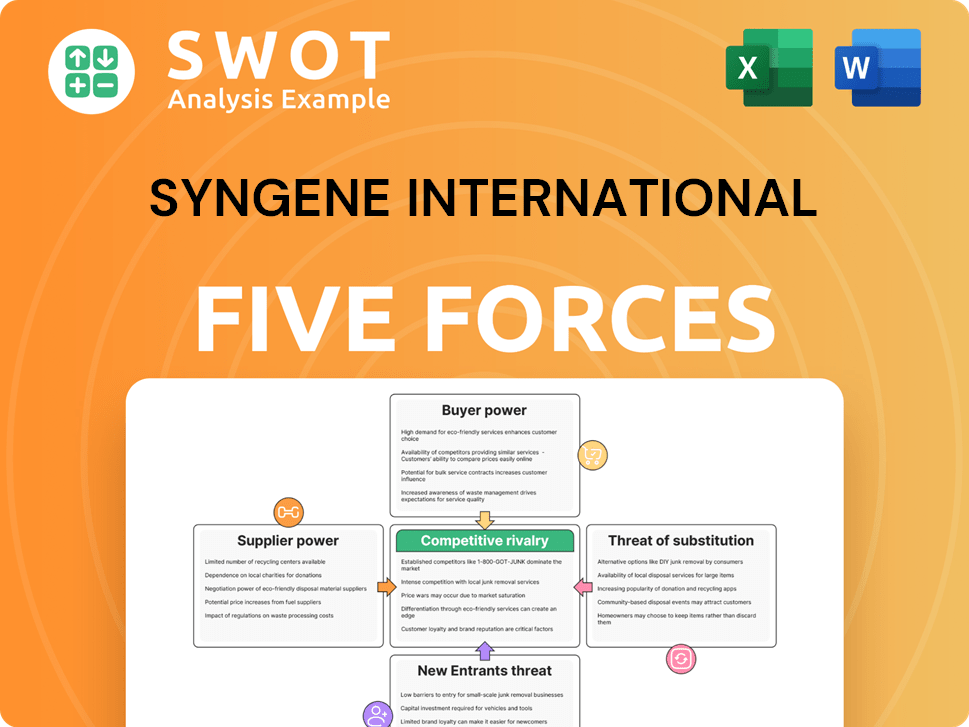
Related Blogs
- What are Mission Vision & Core Values of Syngene International Company?
- What is Growth Strategy and Future Prospects of Syngene International Company?
- How Does Syngene International Company Work?
- What is Sales and Marketing Strategy of Syngene International Company?
- What is Brief History of Syngene International Company?
- Who Owns Syngene International Company?
- What is Customer Demographics and Target Market of Syngene International Company?
Disclaimer
All information, articles, and product details provided on this website are for general informational and educational purposes only. We do not claim any ownership over, nor do we intend to infringe upon, any trademarks, copyrights, logos, brand names, or other intellectual property mentioned or depicted on this site. Such intellectual property remains the property of its respective owners, and any references here are made solely for identification or informational purposes, without implying any affiliation, endorsement, or partnership.
We make no representations or warranties, express or implied, regarding the accuracy, completeness, or suitability of any content or products presented. Nothing on this website should be construed as legal, tax, investment, financial, medical, or other professional advice. In addition, no part of this site—including articles or product references—constitutes a solicitation, recommendation, endorsement, advertisement, or offer to buy or sell any securities, franchises, or other financial instruments, particularly in jurisdictions where such activity would be unlawful.
All content is of a general nature and may not address the specific circumstances of any individual or entity. It is not a substitute for professional advice or services. Any actions you take based on the information provided here are strictly at your own risk. You accept full responsibility for any decisions or outcomes arising from your use of this website and agree to release us from any liability in connection with your use of, or reliance upon, the content or products found herein.